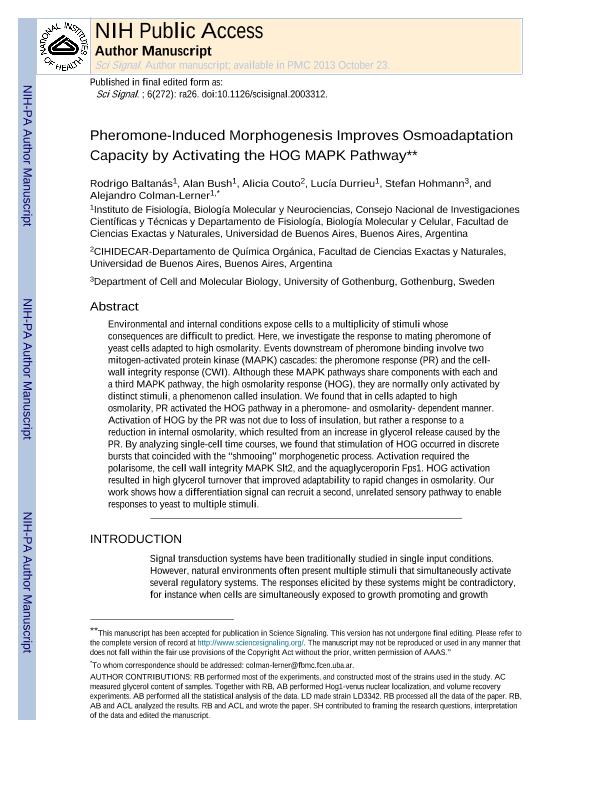Artículo
Pheromone-induced morphogenesis improves osmoadaptation capacity by activating the HOG MAPK pathway
Baltanas, Rodrigo ; Bush, Alan
; Bush, Alan ; Couto, Alicia Susana
; Couto, Alicia Susana ; Durrieu, Lucía
; Durrieu, Lucía ; Hohmann, Stefan; Colman Lerner, Alejandro Ariel
; Hohmann, Stefan; Colman Lerner, Alejandro Ariel
 ; Bush, Alan
; Bush, Alan ; Couto, Alicia Susana
; Couto, Alicia Susana ; Durrieu, Lucía
; Durrieu, Lucía ; Hohmann, Stefan; Colman Lerner, Alejandro Ariel
; Hohmann, Stefan; Colman Lerner, Alejandro Ariel
Fecha de publicación:
04/2013
Editorial:
American Association for the Advancement of Science
Revista:
Science Signaling
ISSN:
1937-9145
Idioma:
Inglés
Tipo de recurso:
Artículo publicado
Clasificación temática:
Resumen
Environmental and internal conditions expose cells to a multiplicity of stimuli whose consequences are difficult to predict. We investigate the response to mating pheromone of yeast cells adapted to high osmolarity. Events downstream of pheromone binding involve two mitogen-activated protein kinase (MAPK) cascades: the pheromone response (PR) and the cell wall integrity (CWI) response. Although the PR MAPK pathway shares components with a third MAPK pathway, the high osmolarity (HOG) response, each one is normally only activated by its cognate stimulus, a phenomenon called insulation. We found that in cells adapted to high osmolarity, PR activated the HOG pathway in a pheromone- and osmolarity-dependent manner. Activation of HOG by the PR was not due to loss of insulation, but rather a response to a reduction in internal osmolarity, which resulted from an increase in glycerol release caused by the PR. By analyzing single-cell time courses, we found that stimulation of HOG occurred in discrete bursts that coincided with the "shmooing" morphogenetic process. Activation required the polarisome, the CWI MAPK Slt2, and the aquaglyceroporin Fps1. HOG activation resulted in high glycerol turnover, which improved adaptability to rapid changes in osmolarity. Our work shows how a differentiation signal can recruit a second, unrelated sensory pathway to fine-tune yeast response in a complex environment.
Palabras clave:
Signal Transdunction
,
Mapk
,
Stress
,
Cross-Talk
Archivos asociados
Licencia
Identificadores
Colecciones
Articulos(CIHIDECAR)
Articulos de CENTRO DE INVESTIGACIONES EN HIDRATOS DE CARBONO
Articulos de CENTRO DE INVESTIGACIONES EN HIDRATOS DE CARBONO
Articulos(IFIBYNE)
Articulos de INST.DE FISIOL., BIOL.MOLECULAR Y NEUROCIENCIAS
Articulos de INST.DE FISIOL., BIOL.MOLECULAR Y NEUROCIENCIAS
Articulos(OCA CIUDAD UNIVERSITARIA)
Articulos de OFICINA DE COORDINACION ADMINISTRATIVA CIUDAD UNIVERSITARIA
Articulos de OFICINA DE COORDINACION ADMINISTRATIVA CIUDAD UNIVERSITARIA
Citación
Baltanas, Rodrigo; Bush, Alan; Couto, Alicia Susana; Durrieu, Lucía; Hohmann, Stefan; et al.; Pheromone-induced morphogenesis improves osmoadaptation capacity by activating the HOG MAPK pathway; American Association for the Advancement of Science; Science Signaling; 6; 272; 4-2013; ra26
Compartir
Altmétricas



